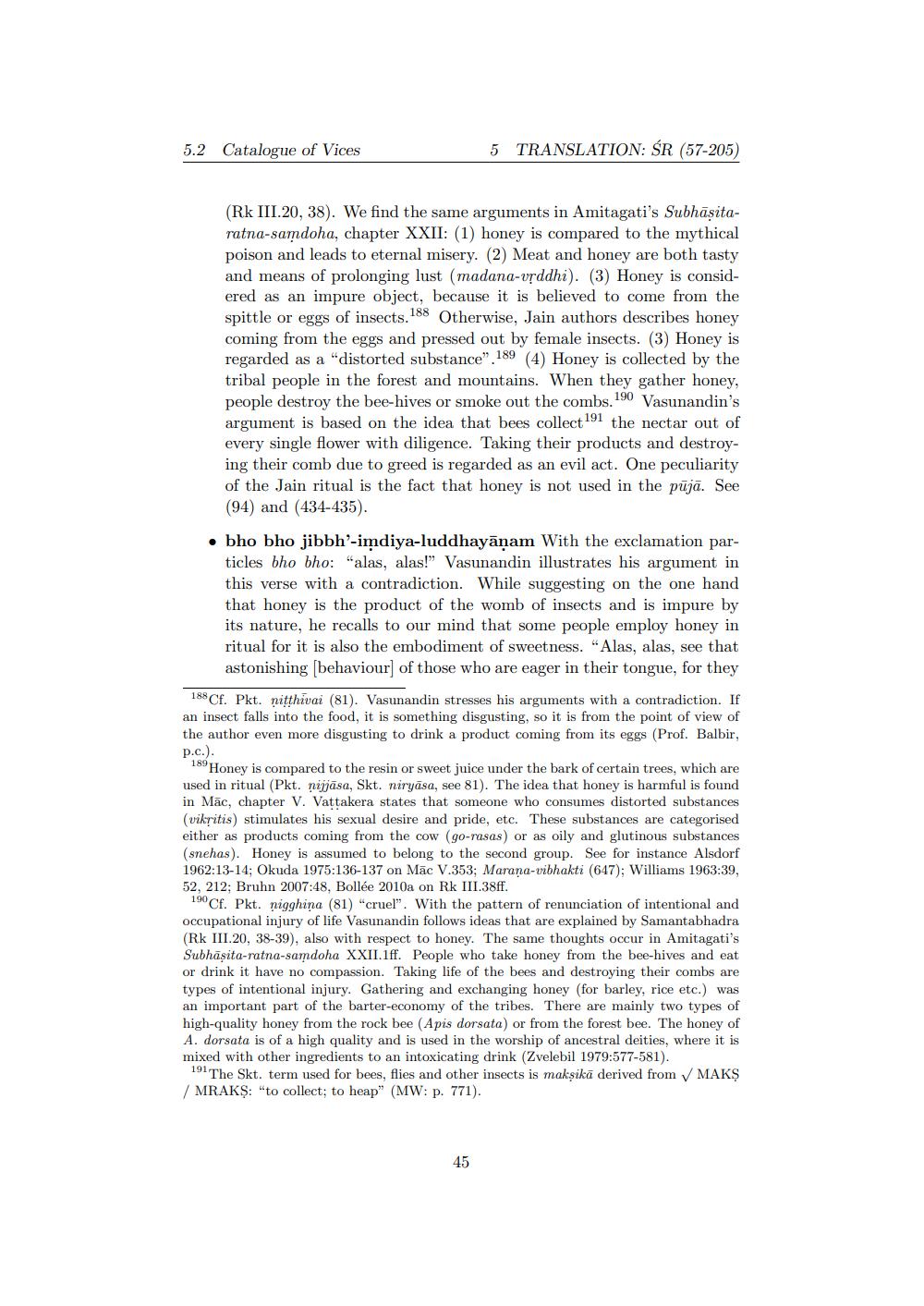________________
5.2 Catalogue of Vices
5 TRANSLATION: ŚR (57-205)
(Rk III.20, 38). We find the same arguments in Amitagati's Subhāṣitaratna-samdoha, chapter XXII: (1) honey is compared to the mythical poison and leads to eternal misery. (2) Meat and honey are both tasty and means of prolonging lust (madana-vrddhi). (3) Honey is considered as an impure object, because it is believed to come from the spittle or eggs of insects. 188 Otherwise, Jain authors describes honey coming from the eggs and pressed out by female insects. (3) Honey is regarded as a "distorted substance".189 (4) Honey is collected by the tribal people in the forest and mountains. When they gather honey, people destroy the bee-hives or smoke out the combs. 190 Vasunandin's argument is based on the idea that bees collect 191 the nectar out of every single flower with diligence. Taking their products and destroying their comb due to greed is regarded as an evil act. One peculiarity of the Jain ritual is the fact that honey is not used in the pūjā. See (94) and (434-435).
⚫ bho bho jibbh'-imdiya-luddhayaṇam With the exclamation particles bho bho: "alas, alas!" Vasunandin illustrates his argument in this verse with a contradiction. While suggesting on the one hand that honey is the product of the womb of insects and is impure by its nature, he recalls to our mind that some people employ honey in ritual for it is also the embodiment of sweetness. "Alas, alas, see that astonishing [behaviour] of those who are eager in their tongue, for they
188 Cf. Pkt. nitthivai (81). Vasunandin stresses his arguments with a contradiction. If an insect falls into the food, it is something disgusting, so it is from the point of view of the author even more disgusting to drink a product coming from its eggs (Prof. Balbir, p.c.).
189
89 Honey is compared to the resin or sweet juice under the bark of certain trees, which are used in ritual (Pkt. nijjāsa, Skt. niryasa, see 81). The idea that honey is harmful is found in Mac, chapter V. Vaṭṭakera states that someone who consumes distorted substances (vikritis) stimulates his sexual desire and pride, etc. These substances are categorised either as products coming from the cow (go-rasas) or as oily and glutinous substances (snehas). Honey is assumed to belong to the second group. See for instance Alsdorf 1962:13-14; Okuda 1975:136-137 on Mac V.353; Marana-vibhakti (647); Williams 1963:39, 52, 212; Bruhn 2007:48, Bollée 2010a on Rk III.38ff.
90 Cf. Pkt. nigghina (81) "cruel". With the pattern of renunciation of intentional and occupational injury of life Vasunandin follows ideas that are explained by Samantabhadra (Rk III.20, 38-39), also with respect to honey. The same thoughts occur in Amitagati's Subhāṣita-ratna-samdoha XXII.1ff. People who take honey from the bee-hives and eat or drink it have no compassion. Taking life of the bees and destroying their combs are types of intentional injury. Gathering and exchanging honey (for barley, rice etc.) was an important part of the barter-economy of the tribes. There are mainly two types of high-quality honey from the rock bee (Apis dorsata) or from the forest bee. The honey of A. dorsata is of a high quality and is used in the worship of ancestral deities, where it is mixed with other ingredients to an intoxicating drink (Zvelebil 1979:577-581).
191 The Skt. term used for bees, flies and other insects is makṣikā derived from ✓ MAKS /MRAKS: "to collect; to heap" (MW: p. 771).
45




